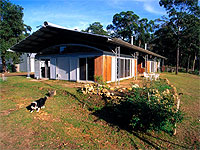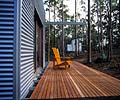Tools & Resources
Green Architecture: The Green Imperative

Lindsay Johnston's 'Four Horizons' home at Watagan Forest, near Newcastle features roofing and walling made from COLORBOND® steel.
| Location: | Watagon Forest, Newcastle, New South Wales |
| Country: | Australia |
| Products Used: |
Walling Roofing |
Green architecture is rising up the agenda and promises to stick around with all of the intensity of El Nino and global warming. The potential and implications for the shape of our cities and suburbs are directly affected. Architects who understand the implications of Green architecture will be that much better placed to survive and prosper.
An international conference on steel in "Green" buildings held in Orlando Florida highlighted the complexities facing architects in their design work and selection of materials. Sponsored by the International Iron and Steel Institute, the conference attempted to clarify the issues surrounding sustainable building materials.
Australia was represented by James Grose of Bligh Voller Nield and Partners, Sydney on the buildings for the 2000 Olympics and Lindsay Johnston, associate professor of architecture, University of Newcastle on his steel framed autonomous house.
One of the International Iron and Steel Institute's objectives was to explore and explode the myths that timber, concrete and mud-brick are the definitive Green building materials. Studies of "embodied energy" - the energy consumed in the extraction, processing and manufacture of materials.
Viewed in the broader context, steel does not shape up so badly. Steel's energy consumption looks more favourable when one considers its potential for decommissioning and recycling over several life cycles. There is also an argument that steel buildings are capable of long span, loose fit, adaptable, "un-bolt" and reassemble solutions - thus extending useful life and writing off annual energy consumption associated with diminishing embodied energy.
Written by Peter Hyatt


